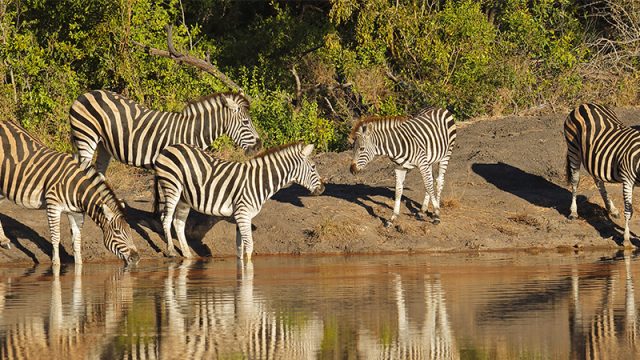Of all the animals most associated with Africa, the zebra, with its bold black-and-white stripes, is hard to forget. If you go on safari in any wildlife reserve on the mainland that’s home to predators, you’ll more than likely see dozens, if not hundreds, of these hoofed, horse-like creatures. So it’s good to know their back story. Here are a few things you didn’t know about African zebras — including why they are hard to domesticate — that you can use as trivia on your next safari.
Sources: Mother Nature Network , African Sky Hunting , National Geographic
This article originally appeared on AFKInsider.com.
1. Why are Zebras striped?
There are a number of theories surrounding why a zebra is striped, but the most prominent has been that they offer camouflage protection in tall grass, and make it difficult for predators to identify individual zebras in a herd. There is a newer theory, however, that the stripes may have evolved as a way to deter blood-sucking insects.
2. No two zebras have the same stripes
A zebra’s stripes are like human fingerprints – each is completely individual. And not only do the stripes vary from zebra to zebra, but three species of zebra each have stripe patterns that are varied in terms of pattern and width. In fact, the farther south in Africa a zebra lives, the farther apart its stripes are.
3. Three varieties of zebras
Wild zebras are indigenous to Africa. Part of the equus family, which also includes horses and donkeys, zebras come in three species: the Burchell’s zebra, which is also called the common or plains zebra; the Grevy’s zebra, named for the 19th century French president Jules Grevy (who once received a zebra as a gift); and the equus, or mountain zebra, a threatened species native to parts of Angola, Namibia and South Africa.
4. Weighing in at…
The Grevy’s zebra is the largest of the three species. They are larger than wild horses and can weigh up to 850 pounds. On the smaller end of the scale is the mountain zebra, which can weigh as little as 400 pounds.
5. Introducing the “Zebroid”
Humans have been fascinated with cross-breeding zebras and other equine species. Today you will find “zorses” (zebra crossed with a horse), zonkeys (zebra crossed with a donkey — pictured above) and zebrules (zebra crossed with a mule) living in captivity across the planet.
6. Why it’s hard to ride a zebra
Unlike horses, zebras run with a zigzagging gait that makes it hard for riders to balance. Zebras are also known to be very stubborn and aggressive, making it really difficult to domesticate the species, although humans have tried for centuries.
7. Difficult, but not impossible, to domesticate
It is not impossible to domesticate zebras, as demonstrated by this team pulling a cart through central London. These zebras were successfully trained by eccentric zoologist Lionel Walter Rothschild at the end of the 19th century, but after doing so, he concluded they it would not be easy to domesticate them on a large scale.
7. The business of hunting zebras
When it comes to trophy hunting, zebra are big business for African outfitters. In South Africa, where zebras can be hunted year round, the trophy fee for a Burchell’s zebra is US$1700 and for a less common mountain zebra, it’s $2700 (in addition to the daily fee charged by hunting camps).
9. Value of a zebra skin
Zebra hides are popular on the global market, with many companies shipping tanned zebra-skin rugs or wall hangings around the world. These usually cost in the neighborhood of US$1200 per skin.
10. These hoofs are made for walking
A baby zebra can be up and walking within 20 minutes of birth. By comparison it takes a horse foal about 90 minutes to get up and walking.
11. Oldest male is responsible for the family
Zebra migrate across vast areas in search of water, and during their migration, it is up to the oldest male in the family herd to make sure the group doesn’t stray too far from water.
12. Social creatures
Zebra are social animals that prefer to move in herds and like each other’s company. They even groom each other. Their diet consists mostly of grass.
Want to discover the finer side of Africa? Sign up for our weekly newsletter.

